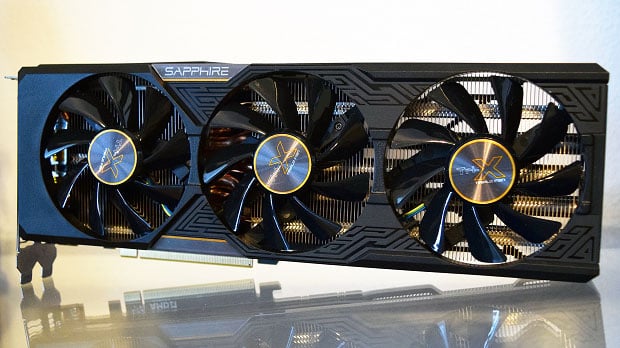AMD Radeon R9 Fury Review: Fiji On Air Tested
Sapphire Tri-X R9 Fury & ASUS Strix R9 Fury
Sapphire went all out its Tri-X R9 Fury, using a custom cooling solution that was 100% designed for Fiji. You’ve got a heatsink array using multiple copper heatpipes with a copper transfer plate, and triple 90mm Aerofoil fans which keep the Fury under 75'C, while still maintaining maximum clocks (that’s the same operating temperature as Sapphire’s Hawaii-based 390x, by the way, which highlights Fiji’s power efficiency).
The card also comes with a bit of LED bling, as AMD’s GPU Tach makes the transition from Fury X to Fury. GPU Tach is a series of 8 LEDs that light up to indicate GPU load. Think of it as a simple way of gauging the amount of work being done by the GPU. Sapphire's variant also provides triple DisplayPort outputs as well as a single HDMI 1.4 port.
Sapphire will have two versions of the Tri-X Fury for launch. One with a standard GPU clock of 1000MHz for $549, and the overclocked version we’re testing with a 1040MHz GPU clock. A Sapphire representative tells us that the standard card will be more readily available at retail, but we’ve opted to publish the results from the 1040MHz card they’ve sent. And quite frankly that’s because achieving your own overclock will be simple with the headroom Sapphire’s cooler allows. More on that in the overclocking section.
Asus STRIX R9 Fury
Asus customized a number of things with its STRIX R9 Fury, including the PCB, which is significantly longer than AMD’s reference Fury X or Fury boards. The changes make the Asus STRIX R9 Fury about the same size as previous-gen, high-end graphics cards (11.8” x 5.4” x 1.57”) despite the form factor advantages afforded by HBM and the Fiji GPU’s design, but what Asus has done seems like a good move with the $579 STRIX.
Unfortunately, we’ve only had the card in-hard for about a day, so we won’t be including a full suite of numbers for it just yet. We do, however, want to cover some of the details and dole out some specs. The Asus STRIX R9 Fury has default GPU clock of 1000MHz, that can be increased to 1020MHz in overclocked mode (even higher clocks should be possible with manual overclocking). The 4GB of HBM is clocked at 500MHz, just like the Sapphire card above and the Fury X.
Outputs on the Asus STRIX R9 Fury consist of a trio of DisplayPorts, an HDMI output, and a DVI output. There are some standout features on the card we should mention too, more specifically, the DirectCU III cooler and beefed-up VRM. The cooler on the STRIX R9 Fury sports triple fans and a dense heatsink array, linked to a solid copper base by dual 10mm heatpipes. The fans will spin down completely when the GPU is operating below 60-68’C range (depending on other system variables) so the card won’t make any noise when idle or during light-duty gaming.
The VRM on the card is a 12-phase design that utilizes high-quality “super alloy” caps, FETs, and chokes. The end result is more stable power deliver and higher efficiency according to ASUS, which aids in overclocking and helps keep board temps down as well. Asus also incorporated status LEDs into the VRM which can indicate whether power connectors are properly seated and working as they should.
Asus includes a 1-year Free XSplit Premium License and a copy of its newest GPU Tweak II utility with the card as well, but we’ll talk about those things when we get a chance to fully evaluate the card. For now, suffice it to say the Asus STRIX R9 Fury exudes quality and based on its specifications, performance should be similar to the Sapphire Tri-X we’ve benched on the pages ahead.












